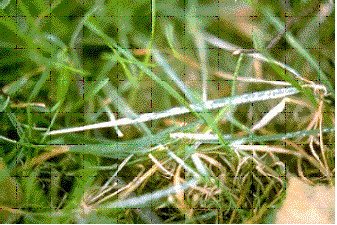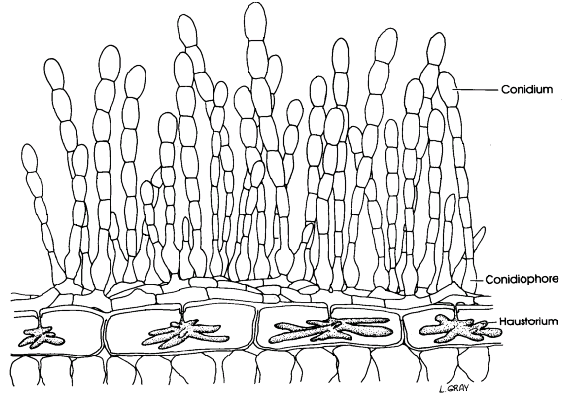Reports on Plant Diseases |
RPD No. 406 - Powdery Mildew of Turfgrasses
|
1995
|
[ Symptoms ] [ Disease Cycle
] [ Control ]
|
Powdery mildew is caused by the fungus Erysiphe graminis, which
attacks a wide range of grasses including cereals. The disease occurs
most commonly on Kentucky bluegrass, bermudagrass, redtop, fine-leaved
fescues, and zoysiagrasses. A number of highly specialized physiologic
races of the fungus are known. Many of these races are restricted
to specific species of turfgrass or to certain cultivars within
a species. The races that attack cereals do not attack bluegrasses
and other turfgrass.
Powdery mildew has become an increasingly important disease of
‘Baron', ‘Cheri', Fylking', ‘Kenblue', ‘Merion',
‘South Dakota Certified', ‘Windsor', and other Kentucky
bluegrasses in recent years. High-nitrogen fertilizers cause a dense
growth of grass that creates an ideal environment for the mildew
fungus. Resistance to powdery mildew is known to exist in several
cultivars of Kentucky bluegrass, bermudagrass, and in several species
of bluegrass and fescues.
The disease is much more severe where air circulation is reduced
and the grass is growing in shaded areas (on north and east sides
of buildings, under dense trees and shrubs). It attacks chiefly
in the spring, late summer, and autumn when days are mild and cloudy
and nights are cool and damp. Because the fungus significantly reduces
the growth of leaves, roots, and rhizomes, powdery mildew is an
important cause of the deterioration of bluegrass and zoysiagrass
lawns in shaded areas. A severe attack may weaken and kill the plants,
especially in crowded, newly planted areas. The surviving plants
are more susceptible to winterkill, drought, and attack by other
disease-causing organisms.
|

Figure
1.
Powdery mildew on Kentucky bluegrass leaves.
|
Symptoms
Powdery mildew appears first as small, superficial patches of white to
light gray, dusty growth (mycelium) on the leaves and leaf sheaths (Figure
1). These patches enlarge rapidly and merge, becoming more dense. The
lower leaves are often completely covered. The leaf tissue under the mildew
yellows soon after infection and later turns tan or brown. Heavily infected
leaves gradually dry up and die. In severe outbreaks, large areas of turf
appear dull white as if dusted with flour or lime.

Figure
2.
Diagram of powdery mildew fungus Erysiphe graminis. The fungus
is on the surface of a leaf except for its feeding organs (haustoria),
which invade the epidermal cells. Drawing by Lenore Gray.
|
Disease Cycle
Powdery mildew fungi live chiefly on the outer surface of the host
plant. They obtain food and water by means of small, branched, rootlike
organs (haustoria) that penetrate the grass leaf or sheath and enter
the surface layer or epidermal cells (Figure 2). The mildew appears
powdery because it produces tremendous numbers of microscopic chains
of spores (conidia). During cool (55 to 70 F; 13 to 21 C), humid
cloudy weather, spores are continuously produced for 7 to 14 days
until the host tissue dies. The conidia are easily carried by air
currents to other grass plants in the same or neighboring turf areas,
where they produce new infections and start the cycle once again.
The conidia are capable of germinating and producing infections
within 2 hours after landing on a leaf. New conidia are produced
within a week after infection occurs.
As the fungus matures, the grayish white powdery growth forms dense
mycelial mats. Occasionally, speck-sized, black, fungus-fruiting
bodies (cleistothecia) develop in the mycelial mats during autumn.
These bodies are especially evident on dead grass leaves. Sexual
or overwintering spores (ascospores) are sometimes produced in the
cleistothecia. Cleistothecia, however, are not common in turfgrasses.
The powdery mildew fungus survives the winter as cleistothecia on
dead plant tissues and as mycelial mats on living grass plants.
The ascospores and/or conidia are released in early spring and produce
the initial infections.
|
Back to Top
Control
- Increase the penetration of light, movement of air, and drying of
the grass surface by pruning or selectively removing dense trees and
shrubs that shade or border turf areas. Space landscape plants properly
to allow adequate movement of air and to avoid excessive shade. Certain
shade-tolerant cultivars of Kentucky bluegrass, such as ‘A-34'
or ‘Bensun', ‘Dormie', ‘Nugget', and ‘Sydspot',
the fine-leaves fescues and rough stalks bluegrass (Poa trivialis)
do relatively well in shade-tolerant ground cover, such as Japanese
spurge (pachysandra), myrtle or periwinkel (Vinca), English ivy,
creeping mahonia, hosta, wild ginger, ribbon grass, and lily of the
valley.
- Keep the turf vigorous and growing steadily by fertilizing on the
basis of a soil test and of local recommendations for the grass(es)
grown. Recommendations will vary with the cultivar or blend grown and
its use. Avoid overfeeding, especially with fertilizers containing large
amounts of soluble nitrogen.
- Water thoroughly (soil should be moist to a depth of 6 inches) during
dry periods. Avoid frequent light sprinkling, especially in the late
afternoon or evening.
- Mow bluegrasses at the recommended height (1½ to 2 ½
inches). Mow frequently so that no more than one-third of the leaf surface
is removed at any one time.
- On high-value turfs, where powdery mildew consistently recurs, a fungicide
program may be economically feasible. When powdery mildew is first evident
in the spring or late summer, two or more applications of a fungicide
at intervals of 7 to 21 days should keep the disease in check. For effective
control of powdery mildew, spray 1,000 square feet uniformly with about
1 to 3 gallons of water containing a small amount of surfactant Always
follow the manufacturer's directions. Thorough coverage of the grass
leaves with each spray application is essential for good control. The
suggested fungicides to control powdery mildew are given in Illinois
Commercial Landscape & Turfgrass Pest Management Handbook or
Illinois Homeowner's Guide to Pest Management. These publications
can be found in your nearest Extension office or the Information Technology
and Communication Services at the University of Illinois. Use lower
fungicide rates in preventive programs, higher rates for curative programs.
Back to Top
|
For further information concerning diseases of crucifers
and other vegetables, contact Mohammad Babadoost, Extension Specialist in Fruit
and Vegetable Diseases, Department of Crop Sciences, University of Illinois at
Urbana-Champaign. University of Illinois
Extension provides equal opportunities in programs and employment.
|



